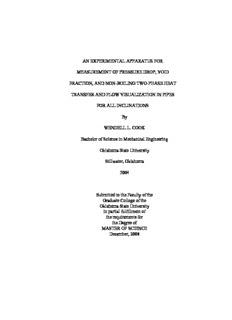
an experimental apparatus for measurement of pressure drop, void fraction, and non-boiling two ... PDF
Preview an experimental apparatus for measurement of pressure drop, void fraction, and non-boiling two ...
ANEXPERIMENTALAPPARATUS FOR MEASUREMENTOFPRESSUREDROP,VOID FRACTION,ANDNON-BOILINGTWO-PHASEHEAT TRANSFER AND FLOW VISUALIZATION IN PIPES FOR ALLINCLINATIONS By WENDELLL. COOK BachelorofSciencein Mechanical Engineering OklahomaStateUniversity Stillwater,Oklahoma 2004 Submittedto theFacultyofthe GraduateCollegeofthe OklahomaStateUniversity inpartial fulfillment of therequirements for theDegreeof MASTER OFSCIENCE December,2008 ANEXPERIMENTALAPPARATUS FOR MEASUREMENTOFPRESSUREDROP,VOID FRACTION,ANDNON-BOILINGTWO-PHASEHEAT TRANSFER AND FLOW VISUALIZATION IN PIPES FOR ALLINCLINATIONS Thesis Approved: Dr.AfshinJ.Ghajar Thesis Adviser Dr.FrankW.Chambers Dr.DavidG. Lilley Dr.A.GordonEmslie Deanofthe Graduate College ii ACKNOWLEDGMENTS I would like to thank my graduate advisor, Dr. A. J. Ghajar for his guidance support and patience and most of all for his friendship throughout my studies as a master’s student as well as through the completion of this thesis. Iwould like to thank all of the colleagues who have worked with me on this research, Clement Tang, Melkamu Woldesemayat, Pranav Godbole, and Nishant Mathure. Special thanks go to Clement without whosehardwork andfriendshipthis researchwouldnot havebeen possible. Very special thanks go to my parents, George and Susan Cook, for their unwavering love and support throughout my college career. This document is dedicated to them for there is little doubt that it is they who instilled me with the perseverance and determination to seethis part ofmyschoolingthroughtoclosure. iii TABLE OFCONTENTS Chapter Page I. INTRODUCTION....................................................................................................1 II.EXPERIMENTAL SETUP....................................................................................8 2.1Test Platform....................................................................................................11 2.2Variable Inclination Frame..............................................................................12 2.3WaterTransport...............................................................................................14 2.4AirTransport....................................................................................................16 2.5Coriolis FlowMeters.......................................................................................17 2.6DataAcquisition..............................................................................................18 2.7PressureTransducer.........................................................................................20 2.8Connections totheTest Area...........................................................................21 2.9TheTest Branches............................................................................................22 2.10TheHeatedBranch........................................................................................23 2.10.1MixingSections.....................................................................................23 2.10.2Flow VisualizationSections..................................................................26 2.10.3Heated Test Section...............................................................................29 2.10.4ThermocoupleArray.............................................................................31 2.11FlowVisualization/VoidFractionBranch.....................................................33 2.11.1MixingSections.....................................................................................35 2.11.2ThermocoupleArray.............................................................................35 2.11.3VoidFractionSystem............................................................................35 2.11.4Flow VisualizationSection...................................................................38 III. CALIBRATIONOFEXPERIMENTAL SETUPAND EXPERIMENTAL PROCEDURE....................................................................41 3.1CalibrationofExperimental Setup...................................................................41 3.1.1PressureTransducer...............................................................................42 3.1.2ThermocoupleArray...............................................................................44 3.1.3Coriolis Flow Meters..............................................................................53 3.1.4VoidFractionSection.............................................................................54 3.2Experimental Procedure...................................................................................55 3.2.1Pre-OperationChecks............................................................................56 3.2.2System WarmUp.....................................................................................57 3.2.3Flow Visualization..................................................................................60 3.2.4PressureDrop Measurements.................................................................70 3.2.5VoidFractionMeasurements..................................................................72 3.2.6Heat Transfer Measurements..................................................................74 iv Chapter Page 3.2.7System Shut Down..................................................................................77 IV. RESULTS ANDDISCUSSION.........................................................................79 4.1PressureDropMeasurements..........................................................................79 4.2VoidFractionMeasurements...........................................................................82 4.2.1Direct Comparison..................................................................................83 4.2.2Comparison withVoidFractionCorrelations........................................88 4.3Heat TransferMeasurements...........................................................................96 4.3.1Single-PhaseLiquidHeat Transfer Measurements................................97 4.3.2Two-PhaseHeat Transfer Measurements.............................................101 V. CONCLUSIONS ANDRECOMMENDATIONS...........................................107 REFERENCES.........................................................................................................110 APPENDIXA: LIST OFEXPERIMENTAL EQUIPMENT.............................113 APPENDIXB: UNCERTAINTYANALYSIS.....................................................117 v LIST OFTABLES Table Page Table3.1: CorrectedThermocouples withAssociatedCorrectionFactors.............49 Table3.2: VoidFractionCorrectionFactors andErrors Associatedwith TestedAngleof Inclination...............................................................55 Table4.1: VoidFractionCorrelations usedfor Comparison Purposes...................90 Table4.2: Experimental vs. CalculatedVoidFractionfor0˚ Incline......................92 Table4.3: DataPoints CorrectlyPredicted within±15%at 5˚ Inclination.............93 Table4.4: DataPoints CorrectlyPredicted within±15%at 5˚ Inclination.............95 Table4.5: DataPoints CorrectlyPredicted within±15%forall Inclinations.........95 Table4.6: SinglePhaseHeat TransferCoefficients................................................99 vi LIST OFFIGURES Figure Page Figure2.1: Schematic oftheExperimental Setup.....................................................9 Figure2.2: Experimental SetupintheFullyVertical Position................................10 Figure2.3: Test Platform andVariable InclinationFrame......................................13 Figure2.4: Schematic ofHeated Branch.................................................................24 Figure2.5: Schematic ofKofloStaticMixer...........................................................25 Figure2.6: Schematic ofPVC / NylonFlange........................................................28 Figure2.7: HeatedTest SectionDimensions andThermocouplePlacement..........30 Figure2.8: Schematic ofFlowVisualization/VoidFractionSection......................34 Figure2.9: PhotographyLightingand BackdropArrangement..............................40 Figure3.1: Calibration ofValidynePressureTransducer for2psi (3-32) Diaphragm.........................................................................................44 Figure3.2: TemperatureDistributionforRe=30,000............................................46 Figure3.3: TemperatureDistributionforRe=10,000............................................47 Figure3.4: Deviationfrom theMeanfortheFirst Series of Isothermal Runs...................................................................................................47 Figure3.5: Raw andCorrectedThermocouple DataforRe =30,000, Temp.=16˚C.....................................................................................51 Figure3.6: Raw andCorrectedThermocouple DataforRe =5,000, Temp.=11˚C (Post Heating)............................................................51 Figure3.7: Raw andCorrectedThermocouple DataforRe =30,000, Temp.=16˚C (Post SecondHeating)................................................52 Figure3.8: PhotographicSetupforFlowVisualizationat 0˚of Inclination...........64 Figure3.9: SlugFlow at 0˚ Inclination(Re = 2200,Re =1800)......................65 SL SG Figure3.10: PlugFlowat 0˚ Inclination(Re =9300,Re =900)......................66 SL SG Figure3.11: AnnularFlowat 0˚ Inclination(Re =5600,Re =18100).............66 SL SG Figure3.12: PhotographicSetupforFlowVisualization at 5˚of Inclination..........67 Figure3.13: SlugFlowat 5˚ Inclination(Re =2200,Re =1200)....................68 SL SG Figure3.14: PlugFlowat 5˚ Inclination(Re =11500,Re =900)....................69 SL SG Figure3.15: AnnularFlowat 5˚ Inclination(Re =8600,Re =17900).............69 SL SG Figure4.1: Calculated vs. Measured Friction FactorValues for Single-Phase LiquidWater................................................................81 Figure4.2: Direct VoidFractionComparison (0˚ Inclination)................................86 Figure4.3: Direct VoidFractionComparison (90˚ Inclination)..............................87 Figure4.4: Experimental vs. CalculatedVoidFractionfor0˚ Incline....................91 Figure4.5: Experimental vs. CalculatedVoidFractionfor0˚ Incline....................93 Figure4.6: Experimental vs. CalculatedVoidFractionfor90˚ Incline..................94 vii Figure Page Figure4.7: Experimental vs. CalculatedNusselt Numberfor Single-Phase LiquidHeat Transfer (0˚ Incline)..............................100 Figure4.8: Direct Comparison ofTwo-Phase Heat Transfer Data from OldandNewSetups...............................................................102 Figure4.9: ComparisonofTwo-PhaseHeat TransferDataFrom NewSetupwithCorrelationofGhajar andTang(2008)................106 viii NOMENCLATURE English LetterSymbols A Amperes or area AWG AmericanWireGauge Btu British thermal units C Celsius cc Cubiccentimeter c Fanningfrictionfactor f C Specificheat p D Diameter Eo Eötvös number F Fahrenheit f Darcyfrictionfactor F Flowpattern factor p F Shapefactor s ft Feet g Grams oraccelerationduetogravity h Heat transfer coefficient gal Gallons hr Hours Hz Hertz ix I Inclinationfactororcurrent ID Innerpipediameter in Inches IPS Ironpipesize K Kelvin k Thermal conductivity L Liters l Length lbm Pounds mass m Meters m Mass flowrate min Minutes Nu Nusselt numberNuhD/k ,dimensionless P Pressure Pa Pascals psi Pounds persquareinch Pr Prandtl number Pr C /k,dimensionless p q Heat transferrate q" Heat Flux Re Reynolds numberReVD/,dimensionless x
Description: